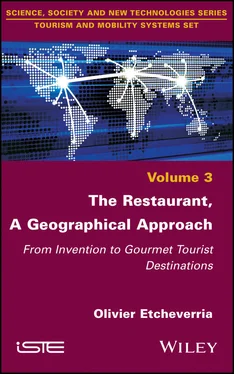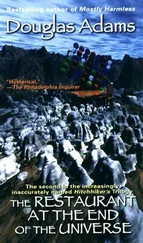“Very quickly, all of Bordeaux was seduced, as was the clientele of cruise ships calling at the nearby port. Then, to verify the emerging reputation of this exceptional 28-year-old master chef, the rich customers of the Café Anglais , owners of the very first motor cars, stopped in Bordeaux on the road to Biarritz, which was then the queen of the seaside resorts.” [MES 98, p. 27, author’s translation]
The restaurant was awarded 3 Michelin stars in 1933. The development of restaurants took place at the end of the 19th Century and at the beginning of the 20th Century. The Dubern restaurant opened its doors in the Allées de Tourny. Paul Dubern created a delicatessen in 1894 at 62 Allées de Tourny, and moved it to number 42 on June 1, 1905, into a bourgeois house. Two renowned restaurants were already established in the area: Le Chapon Fin and Le Café Anglais . In 1914 or 1919, Dubem set up a restaurant on the first floor. After World War I, new restaurants opened on and near the backstreets: Restaurant Italien , Moderne , Madrid , etc. 1 . Starring in the Michelin Guide , the restaurant thus became an “institution” of the city, frequented by both Bordeaux residents and tourists on the way to the Basque Coast. In December 2016, the restaurant was bought by Yunjie Zhou, who already owned Château Renon in Tabanac, since March 2015. In 2018, he opened the restaurant Quanjude and developed a franchise. The restaurants of the Chinese chain Quanjude specialize in Peking duck. The cuisine is provided by Olivier Peyronnet (formerly of Shangri-La Paris ) and four Chinese chefs, including Feng Xu, great master of the Peking duck, and the service by Fabrice Rollo (formerly of La Tour d’Argent in Paris) and William Numa.
In the provinces, restaurants appeared particularly in and around stations. Indeed, the railway came to be a tool for guiding the geographical diffusion of restaurants and the station became a favored anchor point. The square ( la place ) and the station road ( avenue de la gare ) were places where restaurants were located. Many provincial cities served by the railway had a station restaurant or a station brasserie, offering a catering service in the form of a buffet. At the initiative of Vincent Bourrel, SNCF’s general secretary, a partnership was established between the company and 64 station buffets in provincial towns “so that dealers could serve, every day, at an affordable price, a tourist menu, that needed to include one or more regional dishes, carefully prepared according to the traditional recipes of good old French cuisine” [AND 55, p. 123, author’s translation].
In cities, old centers and station districts were hubs, centers of density and diversity, animated by lines and links that were as much tangible as intangible. They were frequented by both permanent and temporary residents.
3.2. … but disrupted by tourism
Philippe Meyzie mentioned that restaurants developed from the beginning of the 19th Century in the spa town of Bagnères thanks to tourist numbers [MEY 07, p. 73].
At the beginning of the 20th Century, the increase in mobility and the deployment of tourist practices accelerated the geographical diffusion of restaurants in the provinces. Thanks to the individual means of transport, cars, the cities, served and linked together by national roads – which constituted axes, structuring the geographical space – became places where restaurants could be set up. Hoteliers promoted the opening of restaurants in their establishments in coastal, thermal and climatic cities.
Route nationale 7 is famous. Throughout its route, restaurants, and especially great restaurants, multiplied in stopover towns. Thus, tourists discovered local products and regional recipes from Burgundy, Lyon and Provence through these restaurants. Jean-Robert Pitte explains:
“To enhance the long journey on the N7, between Paris and the Côte d’Azur, wealthy Parisians then got into the habit of treating themselves to stages of discovery and gastronomic pleasure. Thus, the success of Alexandre Dumaine at the Côte d’Or in Saulieu, of Mère Brazier in Lyon or at the Col de la Luère in summer, of Fernand Point at La Pyramide in Vienna, of Raymond Thuillier at the Oustau de Baumanière in Les Baux-de-Provence, etc. could be explained. Never before would a great chef have dared to serve snails, gratin dauphinois or a simple leg of lamb with herbs. Today, such dishes are required by customers alongside lobster and truffle foie gras, which retain their prestige everywhere.” [PIT 96, p. 776, author’s translation]
Many restaurants that obtained 3 Michelin stars between 1933 and 1939 were located along and near this “diagonal gourmet” [BAI 91] (see Figure 3.1).
On the French Riviera, it was not until the second half of the 19th Century that restaurants developed, thanks to the attendance of British tourists in particular, especially during the winter. The restaurants initially settled in the main cities of the coast, notably in Nice. This development was encouraged by the arrival of the railway, in Cannes in 1863, Nice in 1864 and Monaco in 1868 (and Menton in 1869). In Nice, restaurants developed in the city center, on the avenue de la gare and along the beach front (the Promenade des Anglais) where the great hotels were built. The names of some restaurants referred to renowned Parisian establishments during the first half of the 19th Century, such as Le Bœuf à la Mode and La Maison Dorée , or had an English sound like Garden-House and London House . The development of restaurants led to the scarcity of guesthouses 2 .
In Brittany, the geographical distribution of creperies is illustrative, as Pierre Flatrès demonstrates:
“The diffusion of creperies takes many forms. In Lower Brittany, the first increase of creperies was seen in towns and seaside resorts, then in tourist areas in the interior and in small towns and large villages in general. It should be noted that along the coastal belt and, more rarely, inland, creperies could be isolated, at the roadside. Finally, creperies also opened in smaller communities. Only a minority of municipalities do not have one. The fashion for creperies has, this time, clearly crossed the linguistic border, which appears poorly on a distribution map. Creperies are indeed quite numerous in some districts of the eastern Côtes-du-Nord and Morbihan. However, in Ille-et-Vilaine and Loire Atlantique, while creperies have multiplied in the main cities, especially Rennes and Nantes – Rennes beats records with some 70 creperies – and, to a lesser extent, in coastal resorts, they are rare outside the cities.” [FLA 90, p. 137]
The geographical diffusion of restaurants in the provinces has generally respected the urban hierarchy. But tourism has been a disruptive factor.

Figure 3.1. Map of 3-star Michelin restaurants from 1933 to 1939 (source: according to [MES 98, p. 22]). For a color version of this figure, see www.iste.co.uk/etcheverria/restaurant.zip
1 1See Pierre Dupuy Schoell, Isabelle Dupuy Schoell, Pierre Chavot, Dubern, une maison bordelaise depuis 1894, Éditions Confluences, Bordeaux, 2013.
2 2See Émilie Tuz, “L’apparition des restaurants de luxe dans les Alpes-Maritimes (1860–1914)”, available online: www.departement06.fr.
PART 2
The Restaurant in Terms of Places and Geographical Spaces
Читать дальше













